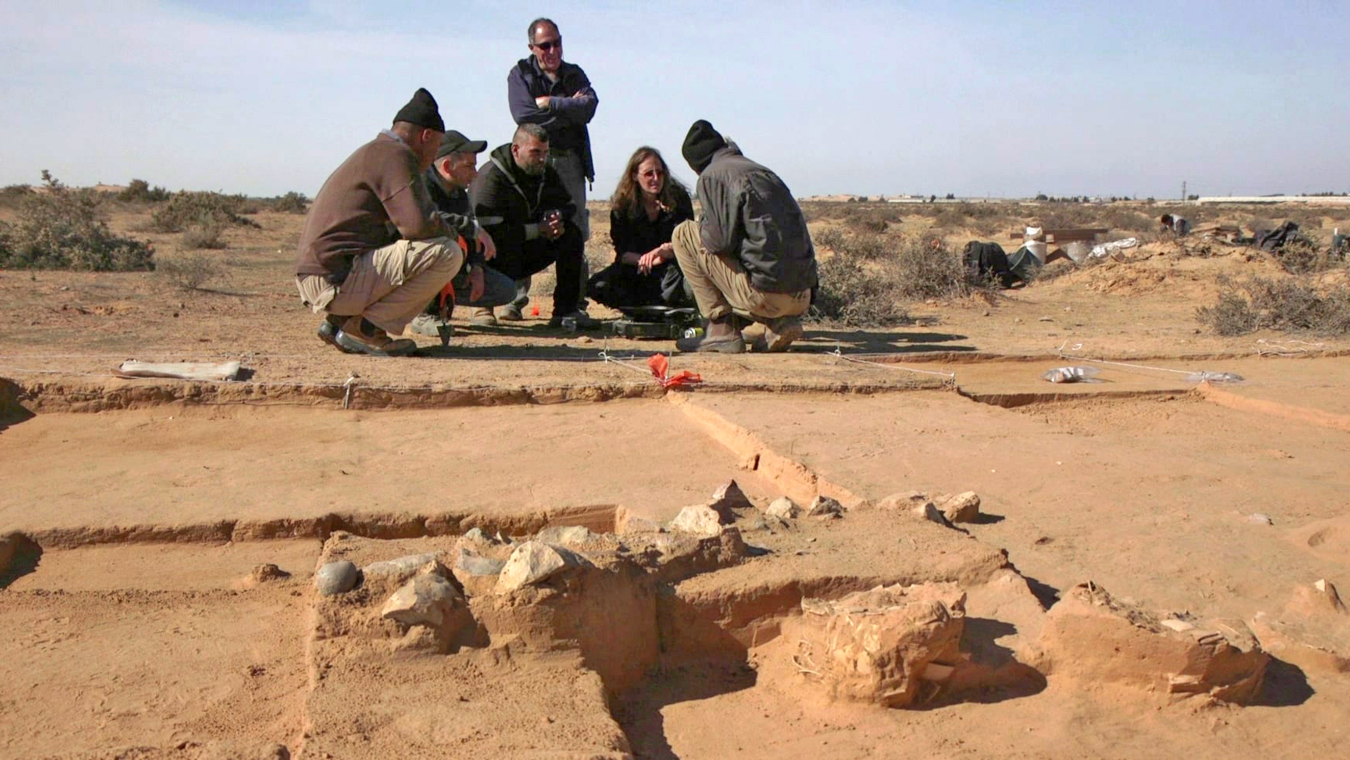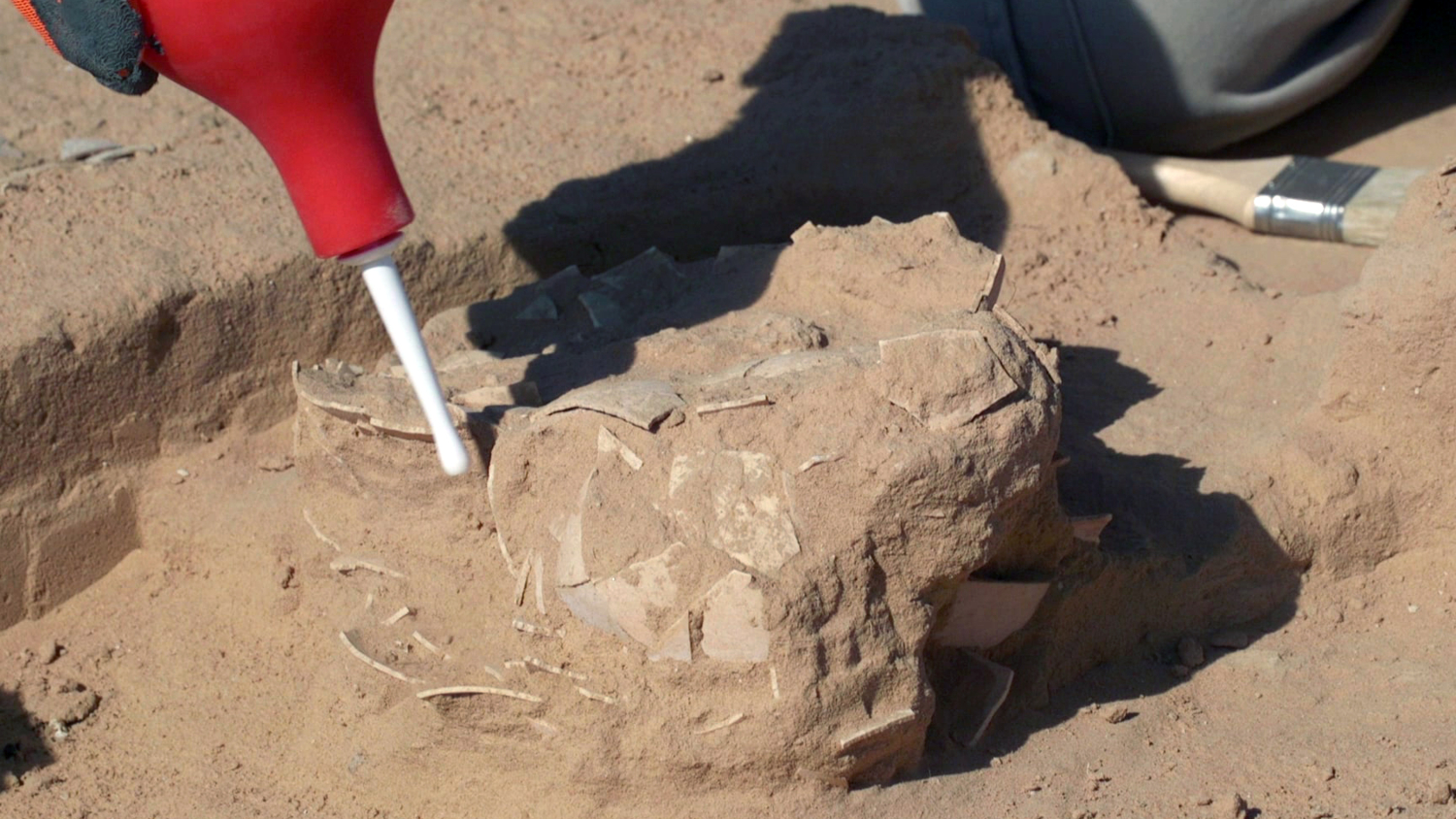Eight ostrich eggs over 4,000-year-old have been uncovered in the Nitzana sand dunes in the Negev, next to an ancient fire pit
The eight large ostrich eggs, all aged over 4,000 years, were found next to an ancient fire pit in an Israel Antiquities Authority excavation, initiated by the JNF and the Ramat Negev Regional Council, undertaken before the development of an agricultural area for Moshav Be’er Milka.
Lauren Davis, the Israel Antiquities Authority excavation director, comments, “This is a very important find that—with the help of modern scientific methods—can teach us a lot about the nomadic people of the desert in ancient times”.
The eggs were uncovered near an ancient fire pit in the Nitzana sand dunes in the Negev. Specifically, the eggs were located in the agricultural fields of Be’er Milka. This rare find has been preliminarily dated between 4,000 and 7,500 years ago.
The excavation was carried out by the Israel Antiquities Authority, initiated by the Jewish National Fund and the Ramat Negev Regional Council plans to prepare new agricultural land for Be’er Milka.
Eggs found at campsite used by desert nomads since prehistoric times

“We found a campsite, which extends over about 200 sq. m), that was used by the desert nomads since prehistoric times”, says Lauren Davis, the Israel Antiquities Authority excavation director.
“At the site, we found burnt stones, flint and stone tools as well as pottery sherds, but the truly special find is this collection of ostrich eggs. Although the nomads did not build permanent structures at this site, the finds allow us to feel their presence in the desert. These campsites were quickly covered over by the dunes and were re-exposed to the sand movement over hundreds and thousands of years. This fact explains the exceptional preservation of the eggs, allowing us a glimpse into the lives of the nomads who roamed the desert in ancient times.”
Indeed, ostriches were common in this location from the early prehistoric periods until they became extinct in the wild in the course of the 19th century. This is not the first find of ostrich eggs. They have, in fact, been discovered in multiple archaeological sites for several periods, reflecting the importance of ostrich eggs as a raw material.
‘One ostrich egg has the nutritional value of about 25 normal chicken eggs!’
“We find ostrich eggs in archaeological sites in funerary contexts, and as luxury items and water canteens. Naturally, they were used as a source of food: one ostrich egg has the nutritional value of about 25 normal chicken eggs!” adds Dr. Amir Gorzalczany from the Israel Antiquities Authority, who has researched the subject extensively.
“There is sometimes even evidence of decorating and incising on ostrich eggs, showing their use as decorative items. It is interesting, that whilst ostrich eggs are not uncommon in excavations, the bones of the large bird are not found. This may indicate that in the ancient world, people avoided tackling the ostrich and were content with collecting their eggs.
“The proximity of the group of eggs to the fire pit indicates that this is not a natural chance find but the intentional collecting of the eggs,” says Davis. “One of the eggs was found directly in the fire pit, strengthening the understanding that they were used as the food here. The ostrich eggs were crushed but well-preserved, despite the fact that they were uncovered in the surface layer.”
‘After the excavation we will reconstruct the eggs, just like a puzzle’
Davis adds that post-excavation scientific examination will add information regarding the exact age of the site. “After the excavation, we will reconstruct the eggs, just like a puzzle. The whole egg may tell us the species, and exactly what they were used for. As far as I’m concerned, every eggshell is worth its weight in gold! I am really looking forward to the research in the labs. The best is yet ahead!”
Eli Escuzido, Director of the Israel Antiquities Authority, commented: “The collection of ostrich eggs from Be’er Milka is a rare and fascinating find. It seems that the eggs survived as they were covered over by the sand dunes for so long, and due to the relatively dry climate of the area. The finds will go directly from the excavation to the new analytical laboratory in the Jay and Jeanie Schottenstein National Campus for the Archaeology of Israel, where they will undergo further observation and research.”

Open Access Government wanted to delve deeper into the fascinating discovery, so arranged an interview with Ms. Lauren Davis, the Authority’s Excavation Director. She provides her responses below.
Why is this find so special?
“The uniqueness of the find is the location of the eggs in relation to the hearth. While the use of eggs as decoration and vessels has been long confirmed this is evidence of very early use of ostrich eggs as food with extremely good preservation of a surface layer site and very good preservation of the eggs, that while crushed, have maintained their shape thanks to the properties of the dune (sand).”
What can the discovery tell us about the nomadic people?
“The site, like any archaeological site, is more than what one item tells us. It is the entire assemblage that gives us a fuller picture of the past. The eggs could give us evidence of how the nomadic people utilized their environment and their decision-making process regarding subsistence. The eggs, if preservation allows, can be dated which would confirm the typological evidence and corroborate the archaeological record. Organic material that is datable is not always easy to find in these environments so this is a very good find. In addition, the reconstruction of the eggs and the examination of their shells not only tell us how they were used but are themselves important environmental indicators.
“Studies can show what type of ostrich the egg belonged to, if the eggs were of the same clutch, it can indicate environmental factors too, which can then shed more light on the climate and how it’s changed through the ages and much more. In addition, finding the eggs together with the Flint and stone tools as well as pottery shards typical of the chalcolithic or early bronze age period teaches us about these specific people from a time period before written communication, where we find many sites just like these. How they used the site? What tools were they making? Why did they choose to make the camp there? Were there activity areas? How large was the site? Were there other uses of the eggs we found on the site? And if not, why not? These are all important questions that the information from the site together with continuing research will teach us.”

What can we learn from their way of life?
“As to what we can learn from their way of life? That is a big question. Archaeological research into the use of the desert throughout antiquities teaches us much about how to utilize and preserve water in an arid desert for instance. It teaches us what types of people and activities took place during a time when their material culture was all they had to leave behind. Knowing our past is knowing who we are and how we came to be.”
How can it benefit science?
“Every egg found is an addition to the scientific corpus, which builds the record of how we define things and know things. Each test reaffirms old techniques or develops new methodologies, as every site comes with its unique challenges. Climactic and archaeological studies are intertwined with how people used the area during different climatic periods. And beyond anything else, archaeology is meant for the basic human interest and yearning to know who we are and where we come from. And at the end of the day using scientific, excavation, topological, experimental etc. methods is our way of answering that question.”
Interview with Ms. Lauren Davis, the authority’s excavation director











